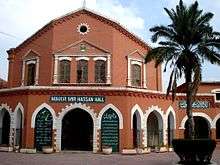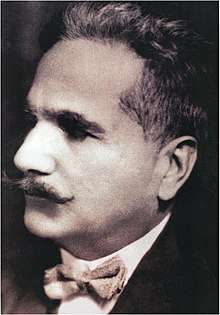Government Murray College Sialkot
Government Murray College Sialkot, (GMC Sialkot) often referred to as Murray College, formerly known as Scotch Mission College, is a government college located in Sialkot in the Punjab province of Pakistan. It was established by the Scottish missionaries as Scotch Mission College in 1889. It was named after Captain John Murray due to his donation of money for purchasing of land.
 | |
| Motto | Urdu: ایمان ، اتحاد ، نظم (first Thing First) |
|---|---|
Motto in English | Faith, Unity, Discipline |
| Type | Public and Co-educational |
| Established | 1889; 131 years ago |
| Principal | Javed Akhtar Billah |
| Students | 6,000 |
| Undergraduates | 5,000 |
| Location | , , |
| Campus | Urban |
| Sports | Cricket, football, table tennis |
| Website | www |
History
Government Murray College Sialkot was established as Scotch Mission College by Scottish missionaries belonging to the Church of Scotland Mission in 1889. The Church of Scotland came to Sialkot (then Part of British India) in January 1857 when the first Scottish missionary, Reverend Thomas Hunter, came to live with his wife, Jane Scott, and baby son near the Brigade Parade Ground, facing the Trinity Church (whose first stone was laid on 1 March 1852). The church was consecrated by the Bishop of Madras on 30 January 1857. Sialkot at that time was in the diocese of Calcutta in British India. Thomas Hunter, his wife and baby son were murdered in Sialkot during the Indian Rebellion of 1857.
The Scottish missionaries who established Scotch Mission College was born and lived in the comparative comfort of Scotland, deeply moral and ordained to the Christian ministry, each one of them educated in one of the five ancient universities of their country. They worked largely without recompense to educate people of a town very different from theirs.
In 1972, the government of Pakistan dismissed the Scottish missionaries and nationalized the institution.
It was initially started in 1868 as Scotch Mission High School, situated in Kanak Mandi, Sialkot, but was in 1889 up-graded to the status of an Intermediate College at the request of Punjab Govt.
Chronology
What is now called Govt. Murray College, Sialkot and takes pride in being the alma mater of the great poet-philosopher of the East, had a very modest beginning. It was initially started in 1868 as Scotch Mission High School, situated in Kanak Mandi, Sialkot, but was in 1889 up-graded to the status of an Intermediate College at the request of Punjab government.
Dr. Muhammad Iqbal joined the school in 1883. He was enrolled as an Intermediate student on 5 May 1893. The early history of Murray College is both interesting and singular. The Foreign Committee of the Ch`urch of Scotland was requested in 1883 to open a college in Lahore. It turned down not only the request of the Punjab Govt.; but even an attractive offer of pounds: 250,000,00 as financial aid by one Sardar Sarwat Singh for the said purpose. The said Foreign Committee, at that stage, perhaps could not even dream that destiny had turned the scale in favour of the people of Sialkot.
In 1889, the Punjab Government again approached the said Foreign Committee to open a college at Sialkot. The Lt. Governor of the Punjab even earmarked a financial grant for the purpose. Consequently, in 1889, the Intermediate section of the College was started in school itself. For 20 years, classes were met in the same building and by almost the same four members, incidentally representing all the major communities of the undivided India, Maulvi Mir Hassan Sahib, Mr. Narinjin Das and Sardar Harnam Singh. They jointly taught seven subjects: English, Philosophy, Arabic, Persion, Maths, Chemistry and Physics.

Dr. Iqbal’s teacher and mentor, served the school and the college for a record period of sixty long years. We salute the great scholar-teacher Maulvi Mir Hassan. In 1890, the total number of students on the college rolls did not go beyond 17. When the college moved to its present premises in 1909, the total numbers of students was 41 only. With the shifting of the college to its present site, its name was changed to Murray College. It was necessitated by a legacy left by Captain Jhon Murray for the College.
The College was formally inaugurated by Sir Louis Dane on 27 Oct 1909. At that time, Rev. Jhon Waugh (1909–1914) was the Principal of the College. His successor Rev. Dr. William Scott (1914–1923) was an untiring dedicated worker. He was followed by the greatest ever builder and disciplinarian Principal, Rev. Jhon Garret (1923–1914). He along with Dr. H. Garrett and brother-in-law Rev. Dr. William Lillie (famous scholar teacher of Philosophy) gave the college the dignity, prestige and academic standard it had not enjoyed so far in the sub-continent.
With the passage of time, the total number of students and teachers multiplied. In 1923, the total number of students was 180, a number that rose to 424 in 1929. With the joining of the Professor R.C. Thomas and in the sub-continent. Prof. C.W. Tressler; a great teacher of History and a stern disciplinarian in 1929, Biology was also offered as an elective subject at Intermediate level. B.A. Honours teaching in English Literature and Maths were started in 1921 followed by M.A. Philosophy and English in 1942, whereas B.Sc., Physics and Chemistry were started in 1944 and 1946 respectively.
After Independence Rev. D. Leslie Scott (1947–1956) who was born in Daska, Sialkot, like his father Rev. D. William had to pull the College through really difficult times, within a couple of years, however, the College was once again on its way to make a humble contribution in almost all the Prestigious fields of national life.
In 1956, the College was given nationalistic touch and Prof. R.C. Thomas a reputed teacher of Biology with 27 years of service to his credit, was appointed as the first national Principal. He retired in 1964. His successor Dr. F.S. Khairullah with almost the same length of meritorious service as Prof. Thomas was an all-time popular teacher of poetry and drama. He was a gifted orator, editor, writer, satirist and humorist. He retired in 1972 at the time of nationalisation of educational institutions of Government. After the retirement of Dr. F.S. Khair Ullah, Dr. Vincent A. Das took over the principal ship of the college in 1972. His approach to all the administrative and academic problems of the college was based on his rich knowledge of Psychology and human relationship. Prof. Dr. Vincent A. Das remained the Principal of the College from 1972 to 1986.
Now in 2010 the college is offering BS(HONS) in 14 Departments. Degree affiliate from university of gujrat.
Professor Ahmed Raza Siddiqui was the first Muslim Principal of Murray College from 1986 to 1992. He is a prolific physicist who studied from notable Nobel laureates during his tenure in England. He holds two master's degree in Physics, one from Punjab University and second one from London. He was first science Principal and the college bloomed during his excellent tenure. He has been praised for his honesty and dedication as a teacher.[1]
There is a beautiful Church in the premises of this college and on the footsteps of this church there is a small cemetery which belongs and reserved for the Khan family of Mori-gate Sialkot. It is said that the land of the college once belonged to this khan family which was donated to build this college. However, the family reserved a piece of land to bury the family members till today. The notable from this khan family is Shahzaad Paan House mori gate & M.I. Khan Lodhi (LLM) advocate.
Faculties and departments
Murray College consists of three faculties and following departments are associated with these faculties;
- Faculty of Natural Sciences
- Faculty of Social Sciences
- Department of BBA
- Department of English
- Department of Political science
- Department of Islamic Studies
- Department of Psychology
- Department of Urdu
- Department of Economics
- Faculty of Biological Sciences
Notable alumni
Scholars
Poets and writers
- Umera Ahmad, novelist, screenwriter
- Allama Muhammad Iqbal, notable modern Islamic philosopher, lawyer, and politician. He inspired the Pakistan Movement in the early 20th century, known as the "Spiritual Father of Pakistan".
- Faiz Ahmad Faiz, one of the most celebrated Urdu poets in Pakistan and as well as in India.
- Waris Mir
Media
- Mumtaz Hamid Rao, former Head of News and Current Affairs of Pakistan Television channel, now Foreign Correspondent of Indus TV Network in UK.
- Khalid Hasan, Pakistan's foremost English-language columnist, editor, and translator.
Sportsmen
- Qaiser Mushtaq, Pakistani cricketer
- Shahid Yousaf, Pakistani cricketer
See also
- Sialkot
- Syed Faiz-ul Hassan Shah
References
- "Archived copy". Archived from the original on 13 September 2013. Retrieved 12 September 2013.CS1 maint: archived copy as title (link)
External links
| Wikimedia Commons has media related to Murray College. |